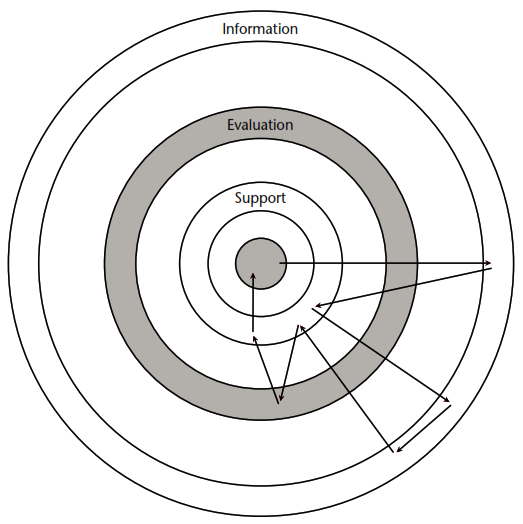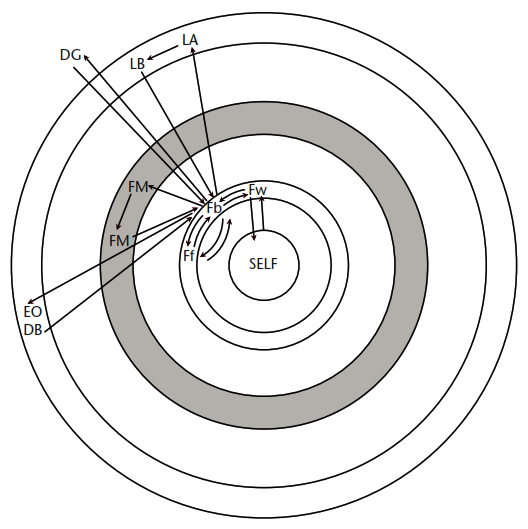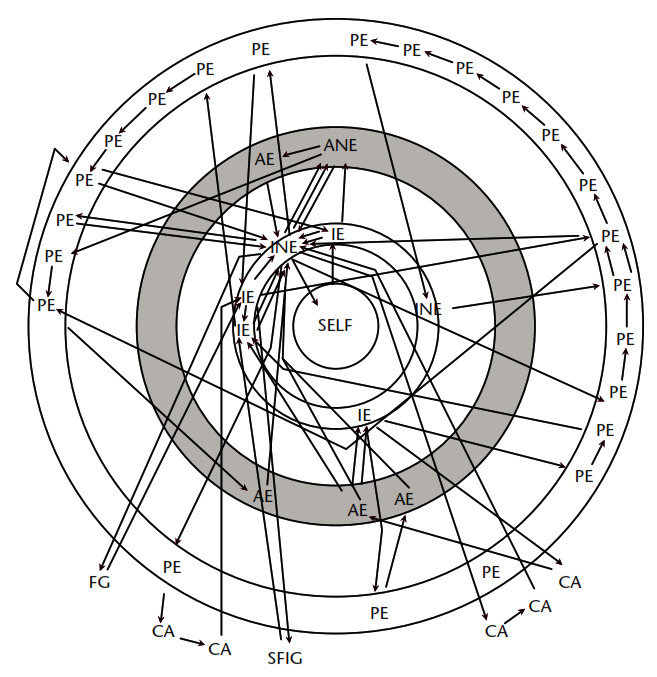422. Risky farm decision making as a social process
Farmers sometimes go through extensive social engagements (conversations, discussions, debates, etc.) in the course of making decisions, especially big risky decisions.
Some fascinating research on this was done by Tom Phillips, a graduate student of agricultural extension at the University of Melbourne (Phillips 1985). It’s old research, but I believe it is still relevant. I’m going to present some examples of Phillips’s results that were published in a book chapter by Neil Barr (Barr 2011).
In the course of tracking who a set of Victorian dairy farmers talked to when considering a decision, Phillips identified three key groups: family, trusted associates, and socially distant subject experts. He created a set of diagrams to depict the sequence of discussions that the farmers had with members of the three groups (Figure 1). On the diagram, the central circle is the farmer who is eventually going to make the decision. The next band, labelled “Support”, represents family and then there is “Evaluation” for trusted associates, and “Information” for subject experts.

Arrows on the figure depict communication events, such as conversations. In the hypothetical example in Figure 1, the farmer first consults a subject expert, then discusses the results with a family member, then has a couple more conversations with an expert, then back to the family, then a trusted associate, family again, and finally makes the decision.
Phillips found widely varying patterns of engagement. For very simple decisions, there would be little or no engagement, but for the most complex and risky decisions, engagement could be remarkably extensive. This partly reflects how much care and effort the farmer was putting into the decision, which will depend on a lot of things: whether it’s a decision that has been made before, how important it is, how risky it is, whether it is reversible, etc.
Figure 2 shows a farmer’s pattern of engagement for a decision about fencing and subdivision of land. It’s understandable that this would require some care as it has ongoing implications for the management of the farmer’s cows, and is not easily reversible or changeable. The figure depicts quite extensive conversations with family members, collection of information from several different subject experts, and a couple of talks with a trusted associate. Interestingly, for this farmer, even the advice of the trusted associate is not acted on directly but is discussed with family members before the final decision. (I don’t know what the positioning of DG outside the outer circle means – presumably that this information source is even more distant.)

And then we have the remarkable image in Figure 3, which is for a decision to build a new dairy shed – one of the most important and consequential decisions that a dairy farmer can make. Just look at it! The tangled web of information seeking, discussion and review indicates an enormous level of care and effort going into this decision. It would have taken quite a long time and, I imagine, been quite stressful.

These figures highlight that risky decision making by farmers is not just a mechanical, mathematical process. They are not just collecting information, doing some calculations and making a decision. Doing calculations would be a critical part of a sensible decision process, but we should appreciate that the calculation results may feed into a complex social process.
Of course, different farmers will have different tendencies to engage with different groups, or to engage at all, so the figures will look very different for different farmers. It would be interesting to know if different types of farmers (e.g., dairy farmers and grain farmers) tend to behave differently in this regard. I expect that farmers in other industries would behave in ways that are broadly consistent with the figures, but I have no idea whether their engagement would be more or less extensive than Phillips found for a sample of Victorian dairy farmers in the 1980s. I’m not aware of this approach having been used in any other research, which seems a shame. On the other hand, considering how demanding it would be for both the farmer and the researcher to get the information depicted in Figure 3, perhaps it is understandable.
Further reading
Barr, N. (2011). I hope you are feeling uncomfortable now: role conflict and the natural resources extension officer, In: Pannell, D.J. and Vanclay, F.M. (eds), Changing Land Management: Adoption of New Practices by Rural Landholders, CSIRO Publishing, Canberra.
Phillips T.I. (1985). The development of methodologies for the determination and facilitation of learning for dairy farmers. Master’s thesis. School of Agriculture and Forestry, University of Melbourne: Melbourne.
This is #15 in my RiskWi$e series. Read about RiskWi$e here or here.
The RiskWi$e series:
405. Risk in Australian grain farming
406. Risk means probability distributions
408. Farmers’ risk perceptions
409. Farmers’ risk preferences
410. Strategic decisions, tactical decisions and risk
412. Risk aversion and fertiliser decisions
413. Diversification to reduce risk
414. Intuitive versus analytical thinking about risk
415. Learning about the riskiness of a new farming practice
416. Neglecting the risks of a project
418. Hedging to reduce crop price risk
419. Risk premium
420. Systematic decision making under risk
421. Risk versus uncertainty
422. Risky farm decision making as a social process (this post)
423. Risk aversion versus loss aversion, part 1
424. Risk aversion versus loss aversion, part 2
433. Depicting risk in graphs for farmers

Farmers alway needs support to increase production but some risk may comes due to climate change , some time risk may be becaused by farmers them selves when they had poor planning that’s why we must be around and advised them